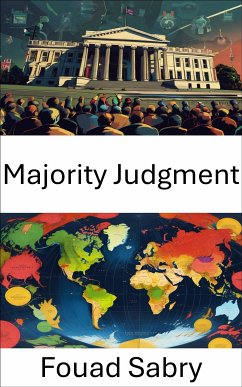In the evolving field of Political Science, grasping innovative electoral methods is key to improving democratic decision-making. "Majority Judgment" offers an in-depth look at a transformative voting system called Majority Judgment, detailing its principles, applications, and significance for democracy. This book is a must-read for anyone interested in modern electoral systems and their role in ensuring fair elections.
1-Majority Judgment-Understand the basics of Majority Judgment and its approach to fair voting.
2-Score Voting-Discover how Score Voting compares with Majority Judgment in enhancing voter satisfaction.
3-Condorcet Method-Learn about the Condorcet Method and its connection to Majority Judgment.
4-Copeland's Method-Examine how Copeland’s Method addresses strategic voting issues.
5-Bucklin Voting-Explore Bucklin Voting and its link to Majority Judgment principles.
6-Ranked Pairs-Understand how Ranked Pairs achieves consensus winners and relates to Majority Judgment.
7-Instant-Runoff Voting-Compare the simplicity of Instant-Runoff Voting with Majority Judgment.
8-Comparison of Electoral Systems-Compare different electoral systems and their strengths alongside Majority Judgment.
9-Evaluative Voting-Learn about Evaluative Voting and its role in Majority Judgment.
10-Usual Judgment-Understand Usual Judgment and its connection to Majority Judgment.
11-Strategic Voting-Address how Majority Judgment mitigates the effects of Strategic Voting.
12-Condorcet Winner Criterion-Learn about the Condorcet Winner Criterion and its relation to Majority Judgment.
13-Participation Criterion-Discover how Majority Judgment supports the Participation Criterion.
14-Majority Criterion-Explore how Majority Judgment ensures a majority-supported winner.
15-Consistency Criterion-Analyze how Majority Judgment meets the Consistency Criterion.
16-Mutual Majority Criterion-Understand the Mutual Majority Criterion and how it aligns with Majority Judgment.
17-Condorcet Loser Criterion-Learn how Majority Judgment avoids electing the least-preferred candidate.
18-Reversal Symmetry-Discover how Majority Judgment upholds fairness in reversed preferences.
19-Cardinal Voting-Explore the evaluative approach of Cardinal Voting and its link to Majority Judgment.
20-STAR Voting-Analyze how STAR Voting combines aspects of Score Voting and Majority Judgment.
21-Highest Median Voting Rules-Learn how Highest Median Voting Rules relate to Majority Judgment.
"Majority Judgment" provides a comprehensive examination of electoral systems, offering professionals, students, and enthusiasts valuable insights into democratic processes. Its analysis extends beyond surface-level knowledge, providing a rich exploration of the impact of various voting methods.
1-Majority Judgment-Understand the basics of Majority Judgment and its approach to fair voting.
2-Score Voting-Discover how Score Voting compares with Majority Judgment in enhancing voter satisfaction.
3-Condorcet Method-Learn about the Condorcet Method and its connection to Majority Judgment.
4-Copeland's Method-Examine how Copeland’s Method addresses strategic voting issues.
5-Bucklin Voting-Explore Bucklin Voting and its link to Majority Judgment principles.
6-Ranked Pairs-Understand how Ranked Pairs achieves consensus winners and relates to Majority Judgment.
7-Instant-Runoff Voting-Compare the simplicity of Instant-Runoff Voting with Majority Judgment.
8-Comparison of Electoral Systems-Compare different electoral systems and their strengths alongside Majority Judgment.
9-Evaluative Voting-Learn about Evaluative Voting and its role in Majority Judgment.
10-Usual Judgment-Understand Usual Judgment and its connection to Majority Judgment.
11-Strategic Voting-Address how Majority Judgment mitigates the effects of Strategic Voting.
12-Condorcet Winner Criterion-Learn about the Condorcet Winner Criterion and its relation to Majority Judgment.
13-Participation Criterion-Discover how Majority Judgment supports the Participation Criterion.
14-Majority Criterion-Explore how Majority Judgment ensures a majority-supported winner.
15-Consistency Criterion-Analyze how Majority Judgment meets the Consistency Criterion.
16-Mutual Majority Criterion-Understand the Mutual Majority Criterion and how it aligns with Majority Judgment.
17-Condorcet Loser Criterion-Learn how Majority Judgment avoids electing the least-preferred candidate.
18-Reversal Symmetry-Discover how Majority Judgment upholds fairness in reversed preferences.
19-Cardinal Voting-Explore the evaluative approach of Cardinal Voting and its link to Majority Judgment.
20-STAR Voting-Analyze how STAR Voting combines aspects of Score Voting and Majority Judgment.
21-Highest Median Voting Rules-Learn how Highest Median Voting Rules relate to Majority Judgment.
"Majority Judgment" provides a comprehensive examination of electoral systems, offering professionals, students, and enthusiasts valuable insights into democratic processes. Its analysis extends beyond surface-level knowledge, providing a rich exploration of the impact of various voting methods.








